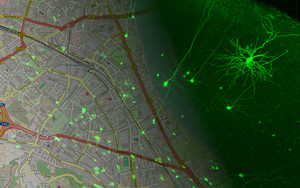Speed data for the brain’s navigation system

DZNE researchers have identified a neural pathway that feeds speed information directly into the brain’s navigation system. Image: DZNE/Daniel Justus; OpenStreetMap
In this study, the researchers stimulated specific areas in the brains of mice and recorded the evoked brain activity. “In previous studies, we found specific cells in the medial septum that fire at higher rates when the mouse moves faster. They function as ‘speedometer cells’. Possibly, they receive their input from deeper brain areas that are involved in motion control”, explains Professor Remy.
Neuronal data bus
These neurons are connected to other brain regions via long-range projections. This includes an area called the “entorhinal cortex” which is considered to be the brain’s navigation center. “The computations needed to navigate in space are ultimately made in this area of the brain,” says Remy.
“We have now been able to show that the rate at which the speedometer cells fire influences neuronal activity in the entorhinal cortex. When the firing rate increases, activity in the entorhinal cortex increases too. The speedometer cells act like a data bus, an interface that relays speed information directly to the brain's navigation center.”
Cause of spatial orientation disorders?
Humans have similar neural pathways connecting the medial septum and entorhinal cortex. Their function has not yet been investigated in detail; however, in the brains of Alzheimer’s patients these connections are known to degenerate early in the progress of the disease.
“The symptoms of Alzheimer’s disease include spatial memory impairments. In such cases, it might happen that an affected person cannot find the way home,” says Remy. “Our results now provide a possible explanation for these symptoms: Information about the ongoing speed of movement is withheld and does not reach the brain’s navigation center.”
Original publication
“Glutamatergic synaptic integration of locomotion speed via septoentorhinal projections”, Daniel Justus, Dennis Dalügge, Stefanie Bothe, Falko Fuhrmann, Christian Hannes, Hiroshi Kaneko, Detlef Friedrichs, Liudmila Sosulina, Inna Schwarz, David Anthony Elliott, Susanne Schoch, Frank Bradke, Martin Karl Schwarz, Stefan Remy, Nature Neuroscience, DOI: http://dx.doi.org/10.1038/nn.4447
https://www.dzne.de/en/about-us/public-relations/news/2016/press-release-no-21.h…
Media Contact
All latest news from the category: Health and Medicine
This subject area encompasses research and studies in the field of human medicine.
Among the wide-ranging list of topics covered here are anesthesiology, anatomy, surgery, human genetics, hygiene and environmental medicine, internal medicine, neurology, pharmacology, physiology, urology and dental medicine.
Newest articles

Properties of new materials for microchips
… can now be measured well. Reseachers of Delft University of Technology demonstrated measuring performance properties of ultrathin silicon membranes. Making ever smaller and more powerful chips requires new ultrathin…

Floating solar’s potential
… to support sustainable development by addressing climate, water, and energy goals holistically. A new study published this week in Nature Energy raises the potential for floating solar photovoltaics (FPV)…

Skyrmions move at record speeds
… a step towards the computing of the future. An international research team led by scientists from the CNRS1 has discovered that the magnetic nanobubbles2 known as skyrmions can be…





















